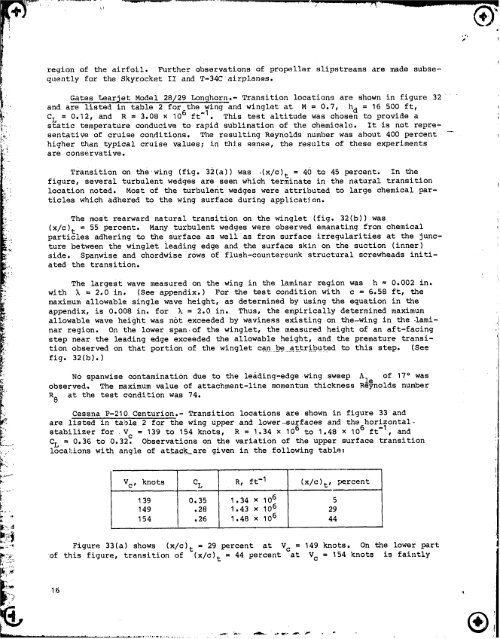NASA Technical Paper 2256 - CAFE Foundation
NASA Technical Paper 2256 - CAFE Foundation
NASA Technical Paper 2256 - CAFE Foundation
You also want an ePaper? Increase the reach of your titles
YUMPU automatically turns print PDFs into web optimized ePapers that Google loves.
i<br />
7:<br />
region of the airfoil. Further observations of propeller slipstreams are made subse-<br />
quently for the Skyrocket II and T-34C airplanes.<br />
Gates Lear_et Model 28/29 Longhorn.- Transition locations are shown in figure 32 ....<br />
and are listed in table 2 for the wing and winglet at M = 0.7, h d = 16 500 it,<br />
C L = 0.12, and R = 3.08 × 106 ft -I. This test altitude was chosen to provide a<br />
static temperature conducive to rapid sublimation of the chemicals. It isnot repre-<br />
sentative of cruise conditions. The resulting Reynolds number was about 400 percent<br />
higher _an typical cruise values; in this sense, the results of these experiments<br />
are conservative.<br />
Transition on the wing (fig. 32(a)) was (x/c) t = 40 to 45 percent. In the<br />
figure, several turbulent wedges are seen which terminate in the natural transition<br />
location noted. Most of the turbulent wedges were attributed to large chemical par-<br />
ticles which adhered to the wing surface during application.<br />
The most rearward natural transition on the winglet (fig. 32(b)) was<br />
(x/c) t = 55 percent. Many turbulent wedges were observed emanating from chemical<br />
particles adhering to the surface as well as from surface irregularities at the junc-<br />
ture between the winglet leading edge and the surface skin on the suction (inner)<br />
side. Spanwise and chordwise rows of flush-countersunk structural screwheads initi-<br />
ated the transition.<br />
The largest wave measured on the wing in the laminar region was h _ 0.002 in.<br />
with k = 2.0 in. (See appendix.) For the test condition with c = 6.58 it, the<br />
maximum allowable single wave height, as determined by using the equation in the<br />
appendix, is 0.008 in. for k = 2.0 in. Thus, the empirically determined maximum<br />
allowable wave height was not exceeded by waviness existing on the-wing in the lami-<br />
nar region. On the lower span of the winglet, the measured height of an aft-facing<br />
step near the leading edge exceeded the allowable height, and the premature transi-<br />
tion observed on that portion of the winglet cad bg_attributed to this step. (See<br />
fig. 32(b).)<br />
NO spanwise contamination due to the leading-edge wing sweep A. of 17 ° was<br />
le<br />
observed. The maximum value of attachment-line momentum thickness Reynolds number<br />
R e at the test condition was 74.<br />
Cessna P-210 Centurion.- Transition locations are shown in figure 33 and<br />
are listed in table 2 for the wing upper and lower_-surfaces and the horizontal_<br />
stabilizer for V = 139 to 154 knots, R 1.34 x 106 to 1.48 x 106 ft -I, and<br />
C L = 0,36 to 0.32 c. Observations on the variation of the upper surface transition<br />
locations with angle of attack_are given in the following table:<br />
Vc, knots<br />
1 39<br />
149<br />
154<br />
C L<br />
0.35<br />
.28<br />
.26<br />
R, ft "I<br />
1.34 × 106<br />
1.43 × 106<br />
1.48 × 106<br />
(X/C)t, percen£<br />
Figure 33(a) shows (x/c) t = 29 percent at V c = 149 knots. On the lower part<br />
of this figure, transition of (x/c) t = 44 percent at V c = 154 knots is faintly<br />
5<br />
29<br />
44<br />
®

















